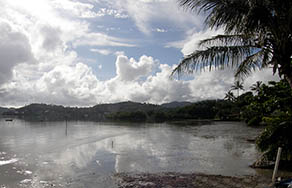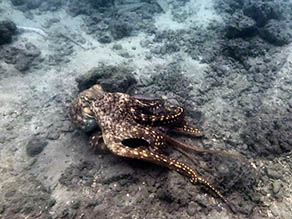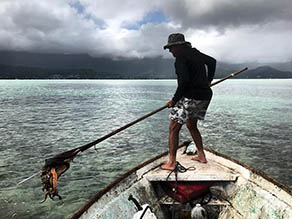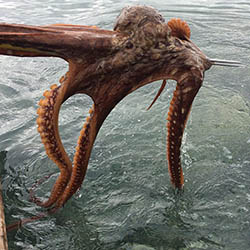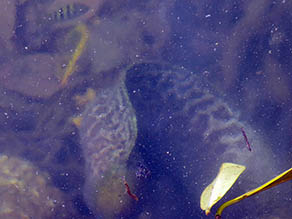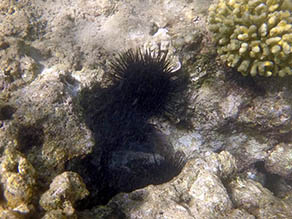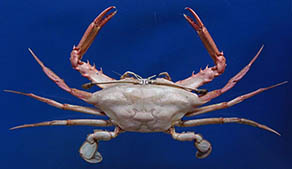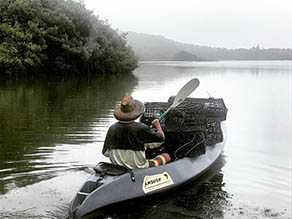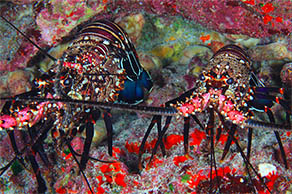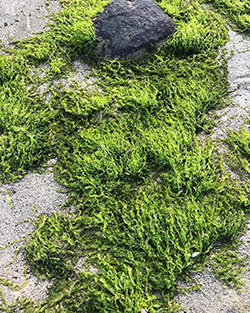 |
 |
 |
 |
||||||
|
|
|
|
|
|
|
|
|
|
 |
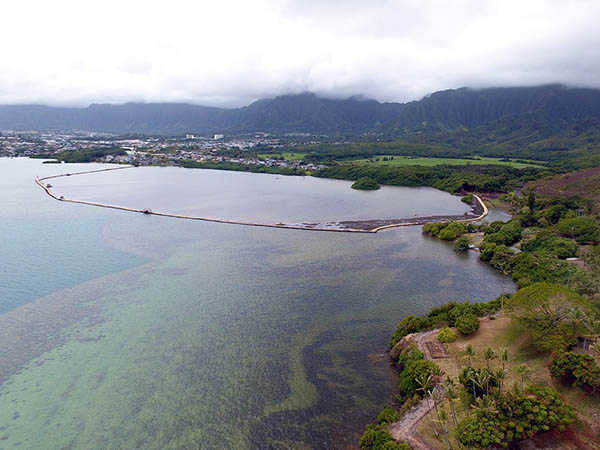
“As you go towards He‘eia, King Intermediate School, that properly was where my mother grew up, Emalia says. “Their lands were right there where the school is, and she used to go down the hill into the bay and gather he‘e in those days. They used to use the squidding boxes, which is a square box with a glass bottom to put on the water so you could go and find the squid holes. She used to go with my grandfather to pick up he‘e. “We’re octopus fishermen,” remarks Hi‘ilei. “That’s been ingrained in us, that’s in our DNA. We understand fairly well the seasonal trends of octopus, at least in Kāne‘ohe Bay. But there’s an ‘ōlelo no‘eau, ‘ka i‘a wale nui o ke Ko‘olau’ that talks about i‘a, the general term for fish or anything that lives in the ocean. 'Wale' is slime or mucus. 'Nui' is big; Ko‘olau, which is our mountain range here. So what is talking about in a poetic way is that what this area is known for: ‘ka i‘a wale nui o ke Ko‘olau,’ which is octopus, he‘e. He’e is that i‘a wale nui: it possesses that sliminess to it. And the reason for their prevelance is just the geography of the bay. “The one source that is plentiful year-round is he‘e. That’s because Kāne‘ohe Bay is littered with shallow reefs that’s prime habitat for octopus. So regardless of if you’re from O‘ahu or from Kāne‘ohe Bay, even outer island people, they all know that if you want he‘e, Kāne‘ohe Bay is kind of where’s it’s at. And then we’ve got off-island family, when they barter or they trade with us, or they bring down smoked meat, or other things, or a cooler full of venison, we send them back with a cooler full of octopus. It’s what we got. “We catch them in different ways. For the most part, if it’s a day like today, kind of a little windy, the surface of the water is choppy, we’ll go diving for them. So just mask, fin, snorkel, three-prong spear, and a kui, which is a T-bar. It’s a long, maybe 6-feet stainless-steel shaft of metal, round with a T on the end, some kind of a stopper. Mine’s already shaped like a triangle, so we basically string up the octopus all the way to the bottom of the T. It’s shaped like that, 6 feet long, and it’s about a quarter inch thick. That’s what we call a kui. Other people put it in the bag, but we like the kui. When you talk about kui lei, is you’re stringing a lei. So it’s a stringer. That’s what we’ll do if the weather is like this. Kui: To string pierced objects, as flowers in a lei, or fish; to thread, as beads. “Certain times of the year, the water will be glass, and then we’ll look from the boat. My dad will go to the bow of the boat, put a little bit of recycled, reused cooking oil from frying fish or whatever. Traditionally, they would use chewed up coconut or chewed up kukui nut. You put a little bit of that in the bottom of the plastic bottle and fill the rest up with saltwater, and you shake it up. You can eliminate any kind of ruffle on the surface of the water with that oil, and makes it so that, basically, it’s like you’re looking through glass. “And he’ll spot. Me too, because I’m his sidekick, his apprentice. On a really good day, we’ll spot octopus fifty feet in front of the boat. He can probably spot them further than I. I'm still like, kind of like under my nose, maybe twenty feet is kind of my distance. Not too often you can see them fifty feet away. That’s on those days during the winter when it’s just like glass. No wind whatsoever, sun is shining so you can see really far. “Today, there’s not too many people that know how to look for octopus at the bow of the boat. That individual is called an ‘okilo he‘e, that practice is called ko‘oko‘o, to poll. You’re basically polling your way along the reef, looking, and then we spear it. “The other way, on really low tide—on a negative tide, when the reef is exposed—we’ll walk on the reef and we’ll catch them that way. We’ll walk on the reef and we’ll catch he‘e with a spear. We use three pronged spear, and we’ll take a bag with us. That’s pretty much the three different ways that we’ll catch them. It depends on the season. “When there’s no wind and the waters like glass, we look for octopus from the boat. So my dad will be on the bow and it’s like a mirror. He spots he‘e in front of the boat. Like 50 feet in front of the boat. And that takes basically a lifetime of training, he‘s 73. So we do that when the water is calm and glassy. “But other than that, any other time, we’re diving. We snorkel, nothing major, just mask, fins and snorkel when we go swimming. So those are the three ways that we catch octopus and that’s kind of what my family is known for." Eels: “Around the fishpond going towards He‘eia state park was where the eels that live,” Alice recalls. “You don’t want to go there. Because they don’t let go of you when they bite. The eels were very, very strong, they were part of the guards of the fishpond. So we used to frequent there.” "I have heard stories of eels either in the mangrove area or upstream," Keli‘i says, "but these are stories from 40-plus years ago and I’m not sure for whatever reason, we just haven’t been here long enough or the environment has changed and those eels no longer exist. Or they don’t do what they used to do when Auntie Alice was in her younger years, or maybe that’s something we just got to wait for. We need to spend more time here. I haven’t seen, only heard the stories. “We do see a couple different species of eels. The main one that we see either crawling around on the bottom or sticking its head out of the rocks is called Undulated Moray. It’s a puhi laumilo, it has a fluorescent green head, brown body with fluorescent green lightning bolt strikes through its body. It’s beautiful. It hides really well except for its fluorescent green head, so if you can spot that head sticking out then you got to stay away from that bugger. They bite. They’ll come after you, sharp teeth. I’ve been bitten couple times by them, they just do it and nice small little slice and perfect for the blood to come out. “We have Conger eels which are tohe or puhi uha. Those eels eat crabs and shrimp so they don’t have teeth but behind the lips of their mouth, they have two crushing plates so they kind of suck crabs and shrimp in and just kind of crush them with their palate. It’s like a really hard palate. Those are big, long brown eels. And then occasionally we’ll see puhi kapa which is another type of moray. So we got Moray eels and Conger eels inside here. “What we saw out here one time, the eels were doing an eel ball. I think that’s their mating behavior, where the boys and the girls just get all together and roll around in a big pile. Other than that I always see just the solitary eel. “One time, my husband saw them breeding," Rocky recalls. “Not everybody sees them breeding. In fact, so many people asked them, ‘What time of year was it?’ He would not give that information because it was something special. Not everybody was going to see that. How the tide was and all that, he never gave that information. But they were all entwined, like balls, big balls. And he said ‘Man, I thought I was going throw my net and catch fish.’ He said, ‘When I looked, it was all balls of eels.’" Wana (sea urchin): “Our family makes the black spine wana,” Hi‘ilei says. “The long, skinny, black-spined kind. That is wana. All the other types are not wana. Wana is the black, long-spined urchins. Other types of urchins—the short-spined ones—those are called ‘ina. There’s also another urchin called a collector urchin, and that’s called hāwa‘e. There’s also the helmet urchin which is called the hā‘uke‘uke. There’s also pūnohu‘ula, the slate pencil urchin which has red spines, or it’s also called the hāwa‘e ‘ula. But every different type of urchin has a different name. The wana is specific to that black one, the one that hurts you big time if you step on it, if you touch it with your fingers. “We would only harvest wana for big family parties because it’s a delicacy and it takes a whole village to prep it. We would go out to the breaker line where the wana lives. My cousin welded us these special tools, basically two-pronged, long with a handle, so that you can keep your distance from your hand away from the urchin. You basically get the wana out from the rocks, and typically the water is like fifteen feet. There’s a lot of up and down involved, so I get really dizzy when I dive for wana. “You grab the wana and you tap it all the way to the surface where there will be a floating basket. Toss it in the floating basket, dive down until your basket’s full, and then we would collect all that we needed, go to Ahu a Laka, where the tourists go. I mean, we could go away from where the tourists are or we could shake the wana spines, and we would! “We would just go in the shallow on the sand and we have a special basket that has handles on both sides of it so you work in pairs. And you put the wana inside and you’re rolling it back and forth. Basically, all of the spines get taken off and they can still poke you even when they’re floating around in the ocean. We would shake it and move to another sandy patch, shake it. And then you get just the test of the urchin, come back to shore in front of my grandma’s house and everybody’s waiting to clean. “So we crack the urchin open, and take out all of the gonads, and clean it. It’s just the gonads and we reserve what we call wana juice, which is the liquid from within the urchin. That’s what we mix with raw lobster for our family parties, the wana and the raw lobster. We cut the raw lobster up so it’s a mixture, and the wana juice is what gives it the flavor. It’s like the gravy. That’s a delicacy that’s been a long time since we've made that. Probably not since my niece’s first birthday party, or maybe my granny’s funeral? I don't remember. Either way, it’s been a while. “The uni you get at a sushi restaurant, it’s different. Totally different. Uni is like rib eye fat, if you ask me. I think that tastes like butter, but wana tastes like seaweed. It’s definitely more salty, briny, but it also tastes of what it eats, which is seaweed, limu. The gonads is what you’re eating. The size of your thumb. If it’s seasoned and it’s really full, then they will be really fat, not like uni. Uni is big. Wana is like the size of your thumb.” Crab & Lobster: “That ocean was full of the white crab,” remembers Alice. “White crabs. We made money selling the white crabs to our own family. I would to go catch every day after school. You have to do some work. We had chickens, and after we feed the chickens we could go down to the sea. “Sometimes if you walk, the white crab kinda come out of the sand and put their leg up so you can step on her where the claws are, where the back part is. They’re out sometimes. We chase them, we chase them and that was fun.” "That’s the kind they of use for crab poke," Keli‘i points out, "but the crab poke in grocery stores here, all of that crab is from Thailand. It’s a species that are very similar to one that we have here. They’re warm-water tropical crabs, blood-spotted swimming crab. We call it kūhonu or kuahonu here in Hawai‘i. "And then there’s mo‘ala which is the long-eyed swimming crab. Those are two just really ‘ono crabs raw that we used to have in abundance here. I remember seeing here about ten years ago that we had a set of floods and that kind of really did a number on the population." “When I was a kid we used to catch small swimming crabs called kūhonu and mō‘ala,” Hi‘ilei says, “and that’s what we used to use for our family parties. We made raw crab and that’s how we got it. Nowadays, the resources aren’t there so we buy it from the store. For people that go offshore, they catch it in deeper waters where it’s abundant. But here in our near-shore fishery, crab is hard to come by—at least those two species of crab.” “The Samoan crabs, there was a lot," Alice continues. "The Samoan crabs get big and they’re good and you get paid if you can catch one. And they’re dangerous too, their pinchers are so big. Oh they’re big but they’re good eating. We had no fish nets. It’s just a stick. If you want to catch the crab, you have to put the stick on the crab and pick it up. Make sure you take the back and not the front because again those claws get the best of you. Just hold it down and you just step on it. Read about oysters and clams in Kāne‘ohe Bay and He‘eia fishpond “Fish ponds are not just fish ponds,” Keahi reminds us. “Fish is a large part of this, but also crabs, from mō‘ala to ‘alamihi to ‘a‘ama to kūhonu. Those crabs are all present here, and pretty abundant. Samoan crabs were introduced and they’re known as mud crabs and mangrove crabs and that's why if you have mangrove present in an area, most likely there’s Samoan crabs present in that same space. “Samoan crabs are very invasive, and not only do they compete with what our native crabs need to eat, they also eat our native crabs who are much smaller and who are actually have a lot less defenses against these Samoan crabs, because they kind of swim on the top of the water, they’re kind of easier to see. "I’ve seen it firsthand. I was out here on Friday night, and we’re holoholo—fishing out here. I shine the light and I see a Samoan crab and he was eating a kūhonu, which is our native white crab. But the Samoan crabs are delicious to eat. We use them as a resource, we definitely eat them. “We are actively harvesting and selling once a month Samoan crab,” Keli‘i adds, “which we’re not farming per se, that is an invasive species. But it grows in the fishpond so we harvest it to eat and it commands a nice price. It’s a very, very tasty crab introduced in the ‘40s, I believe brought from Samoa, so we call it Samoan crab. But it is a crab that grows around the world with mangrove, so it’s called mangrove crab. We’re harvesting that once a month. The three restaurants that we sell it to can’t get enough of it. “We do have a very small amount of native crabs in the fishpond, and we hope maybe by harvesting down the invasive Samoan crabs, that the native crab population will rebound. Haven’t seen signs of that yet but our hopes are still up. “There are a few other smaller crabs that just inhabit the pond,"Keli‘iadds, "but we don’t really eat them or anything, they’re just a part of the ecosystem.” “We used to have a lot of lobster in the bay," Hi‘ilei continues: "Hawaiian spiny lobster. My dad guys used to pick up lobsters all the time. At every big family thing, we used to have a big GI pot full of lobster every New Year’s Eve. GI, military-issue pot like two-feet tall, three feet around. Full of lobster. Everybody would come to our family on New Year’s Eve. There are like 200 people we used to have. "It started becoming very difficult, this happened maybe fifteen years ago already, it started becoming really difficult to find lobster. I told my dad, ‘Wait, we don't eat lobster any other time of the year. But yet we fill up the pot with lobster for all of these people that come to our family house, but we don’t get to enjoy it year-round, I think something is wrong with that picture.’ “It got to the point where all of our lobster holes didn’t have lobster in it. And so we made a conscious decision to stop doing that and instead we started filling the pot with Samoan crab. An introduced species that is just a delicious, but kind of guilt-free.” Limu (seaweeds): “My mother said maybe twice a week down to the fishpond to clean and then get as much limu as they could to feed the fish,” Emalia recalls. “And of course once the fish got big enough, to take them home. That’s what it was for: to raise food for them. “We ate all kinds of limu from here. This south end of the bay, before 1960, produced so much limu, all different varieties. And then the city built a sewage outfall plant which killed all of it and then there’s nothing we’ll eat out of there now. My brothers still go holoholo, they still go fishing because they know where the fishing spots still are in the bay—way outside of course, beyond Mōkapu. They know about all the fishing areas on Mōkapu and the sacred spots.” “Limu grow in these ponds,” Hi‘ilei says. “Today, kind of sad, we have mostly invasive limu in our pond but it’s edible so we have got gracilaria salicornia, which is known as Gorilla Ogo—great, great limu to eat. But I assume one hundred years ago these ponds were filled with native limu. And when there’s abundance of fresh water, we see our ‘ele‘ele limu start to bloom and some other limu that are native. We have some limu cages where we are trying to introduce a variety of manauea back to the bay. So definitely the pond produced limu for us to eat, and for fish to eat, so win-win on that. “Different types of seaweed, we’ll gather a bunch and then we’ll keep it in the freezer and use it over the course of the year as we need it for our poke and our different dishes that we use.” ‘Ōpae (shrimp): “There is an abundance of ‘ōpae here,” Hi‘ilei states. “We have a lot of shrimp, from very small ones to the ‘ōpae lōlō, which are quite a bit bigger, edible and good food for us. We’ve seen an array of different things at least visit the pond from time to time, whether it’s a few different he‘e that have come up on the outside—right outside the wall, like literally on the wall, stuck to the wall and gravel—the mūhe‘e, which are the squids, we’ve seen them. So this place has life and it’s not just for fish. “A lot of the gathering we do is associated with big family functions so it’s reserved. We don’t do it except if there is like a big family lū‘au, a big life-changing event, marriage, baby lū‘au, first birthday party, death in the family, those kinds of big events sort of will go and we’ll gather sea urchins and such.”
|
 |
|||||||
 |
Fishing on and beyond the reef was an essential part of life at He‘eia. More about fishing is discussed in the next page.
|
 |
||
 |
|
 |
||

|
 |
||||
|
||||
Copyright 2019 Pacific Worlds & Associates • Usage Policy • Webmaster |
||||
